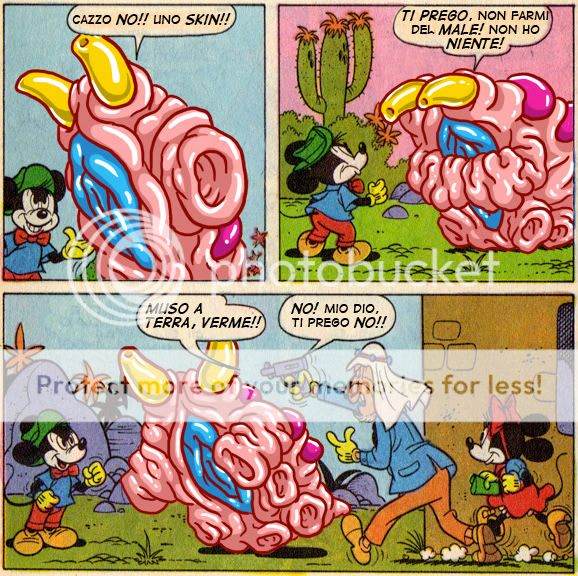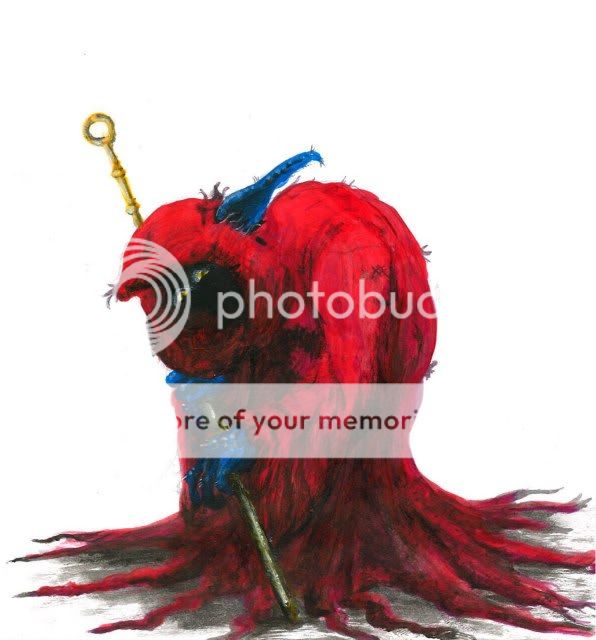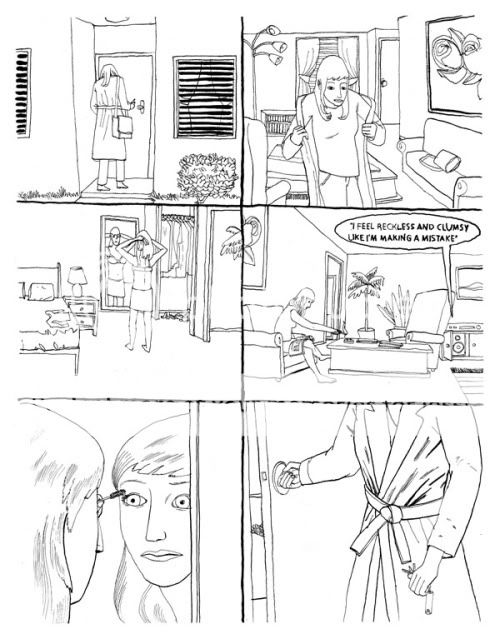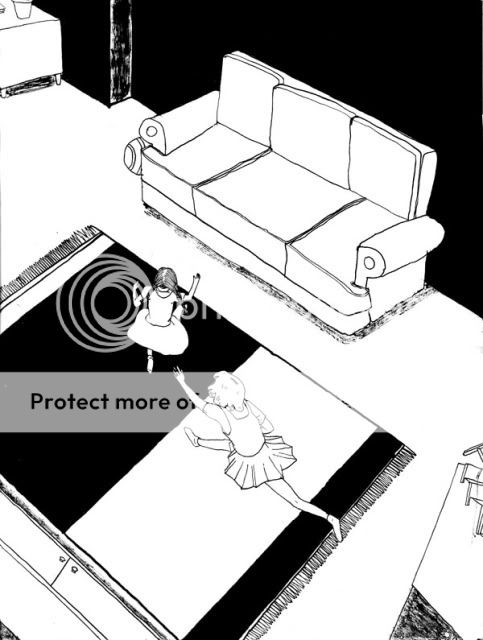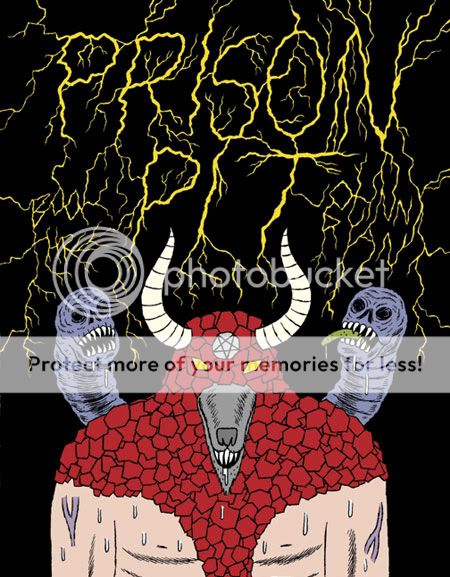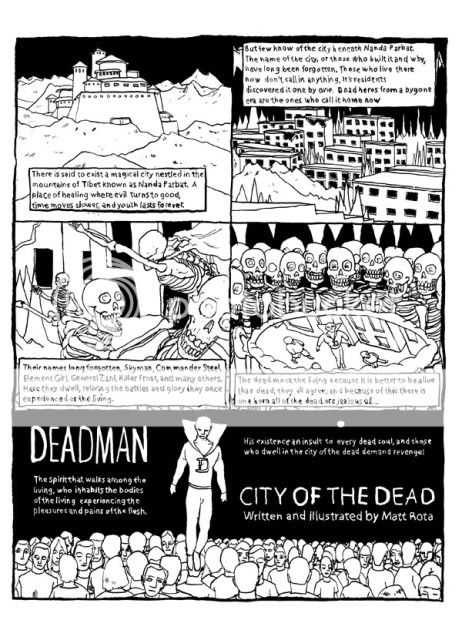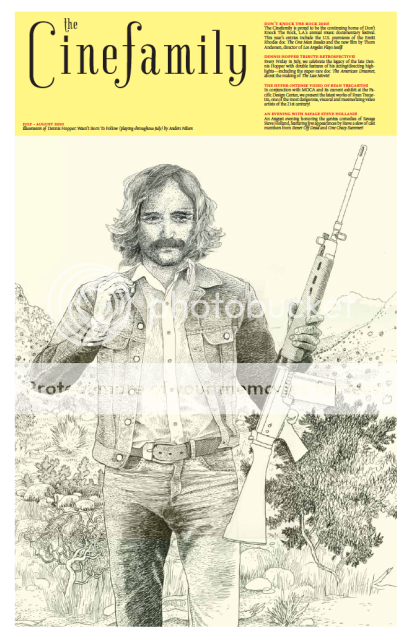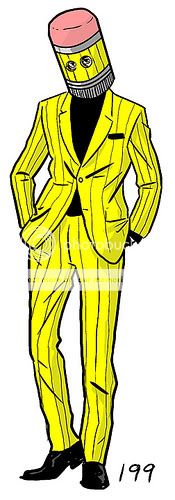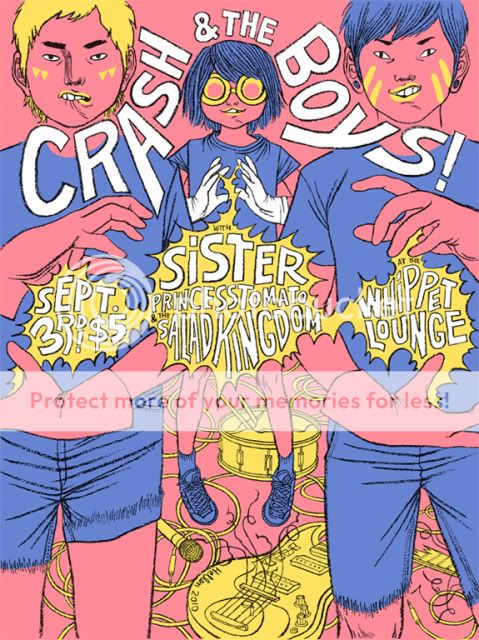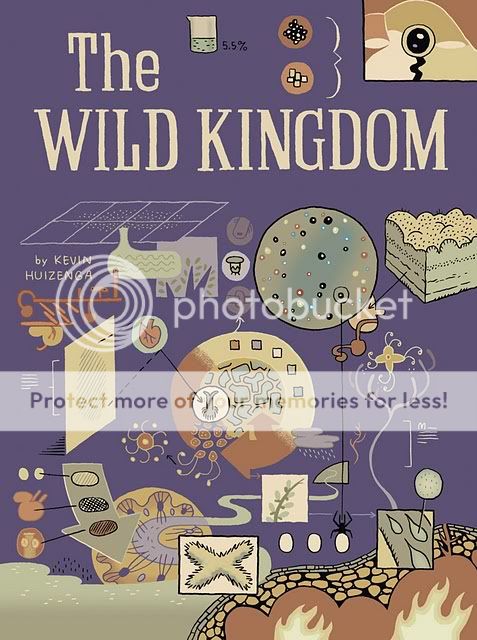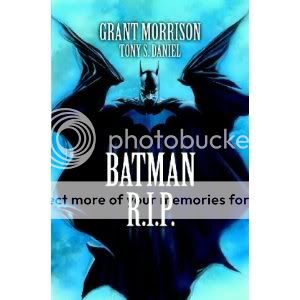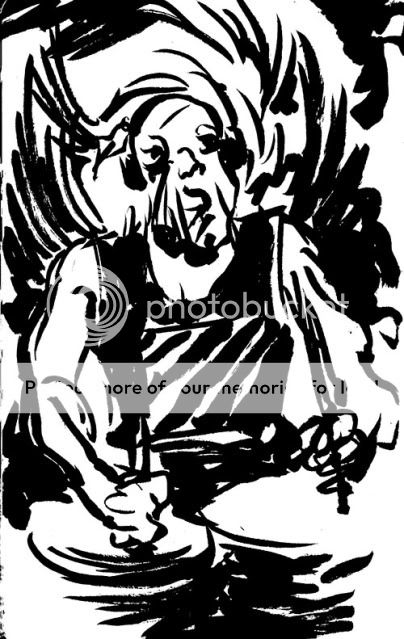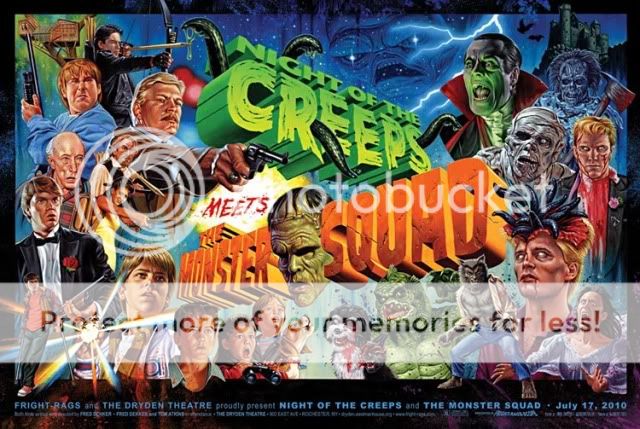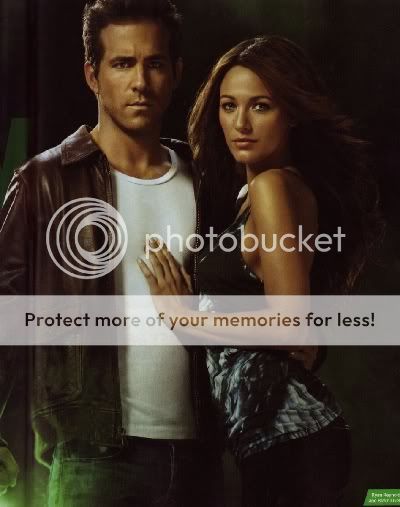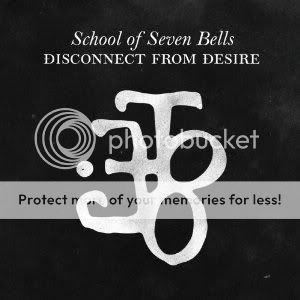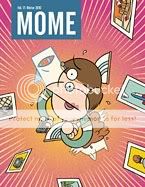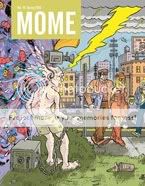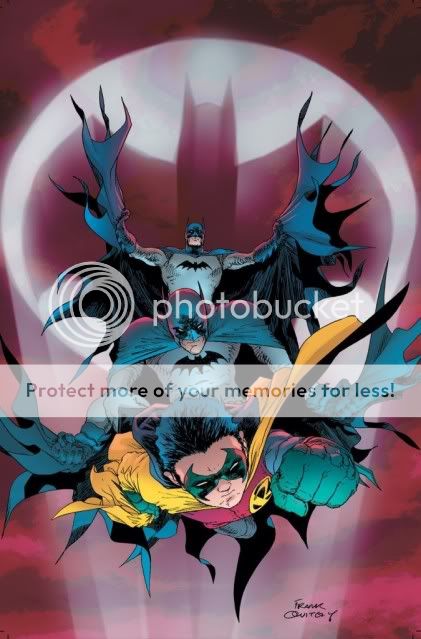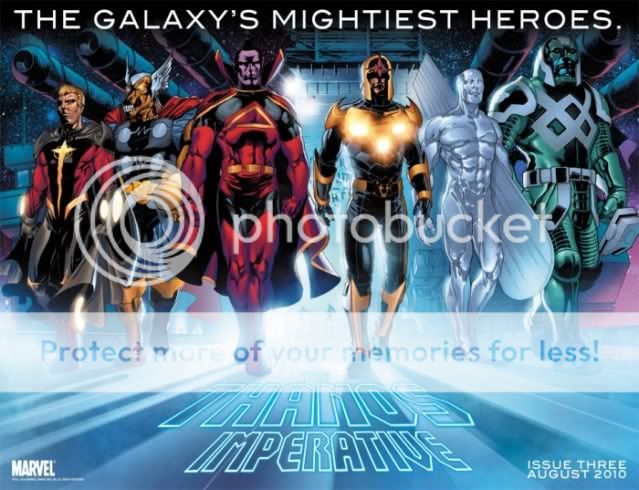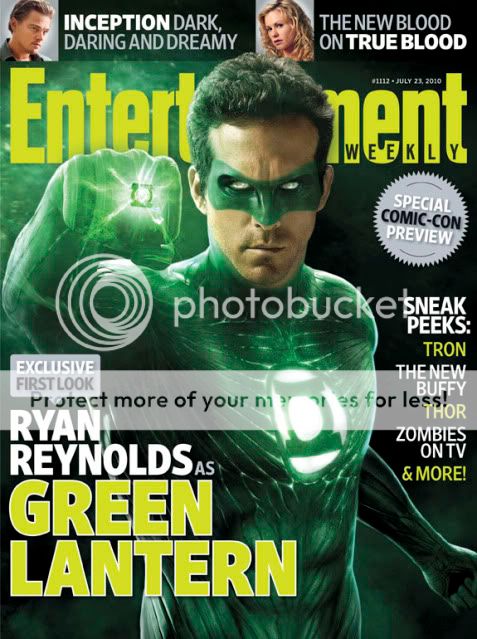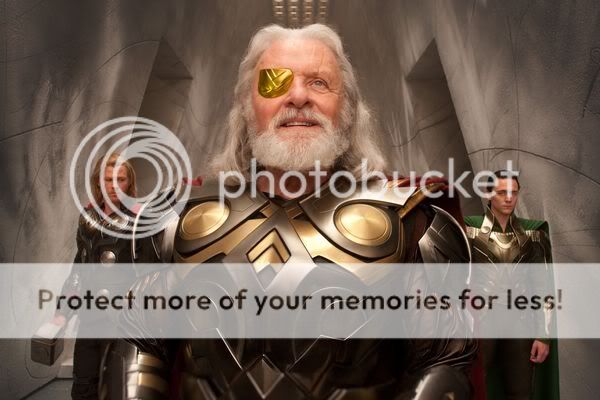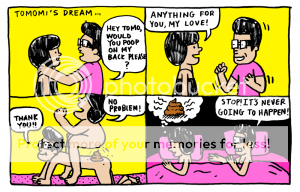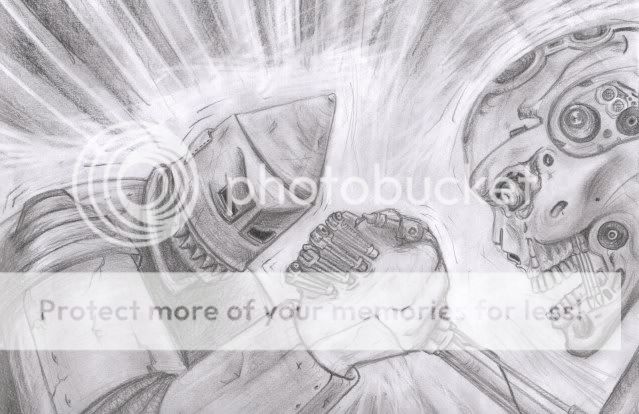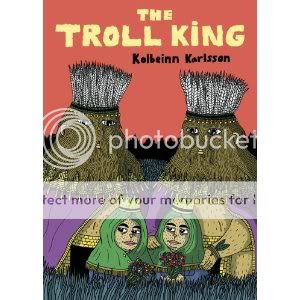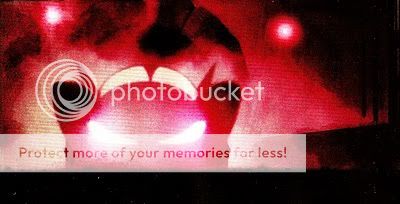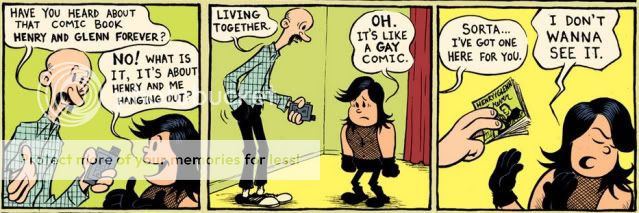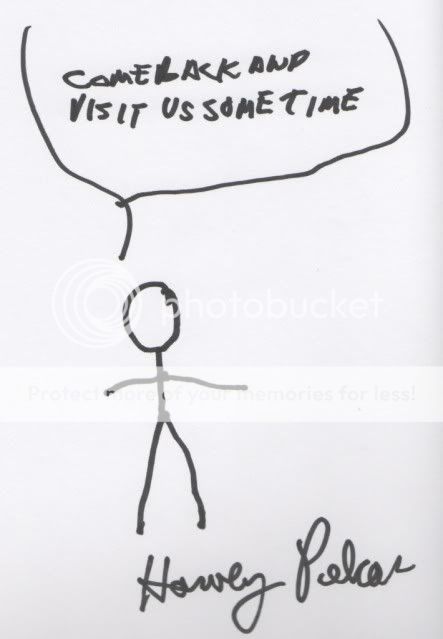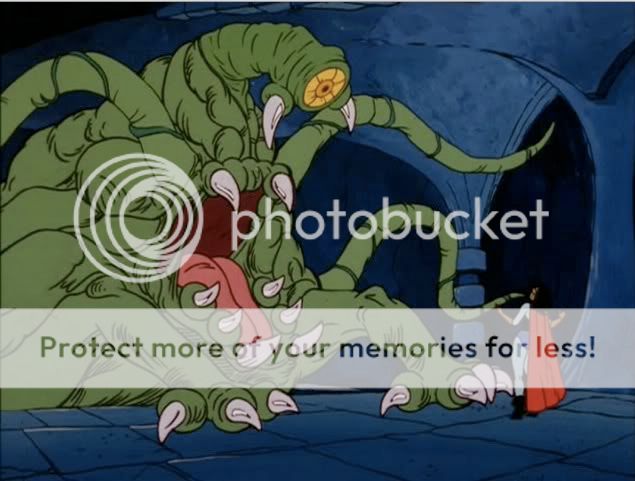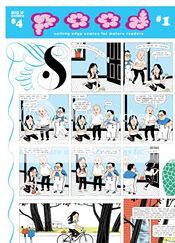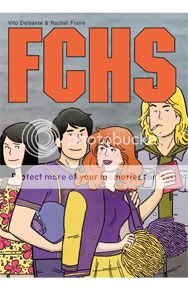Archive for July 20, 2010
Carnival of souls
July 20, 2010* Even though there’s nothing more depressing than the phrase “Buenaventura Press Gone Out of Business Sale,” I’m glad Alvin will be at San Diego, and it sounds like he’s bringing quite a treasure trove with him.
* Dan Nadel reports that Ben Jones is in Los Angeles to work on his Adult Swim show, which is great news because I thought its defeat in that online contest meant it was dunzo.
* Every so often the Internet collectively decides that an interview with a celebrity between whose brain and mouth, to paraphrase Hesh Rabkin, exists no interlocutor is worth your time. Once again the Internet is totally right–you really oughta read Dan Fierman’s interview with Bill Murray in GQ. Did I mention it features a portrait of Murray by Daniel Clowes? (Via Tucker Stone.)
* Vacon Sartirani’s “Mickey Mouse Against the Worms” is fucking me up.
* I give you Orko by Adam Kropinak. I think my favorite part of this is the faded, barely visible O on his cloak, like it’s some ancient rune the meaning of which is lost to time.
* Now that I’ve finally seen Mulholland Drive, it’s time to gorge myself on all the writing about the movie I’d avoided for lo these past nine years. Here’s Matt Zoller Seitz. Here’s Salon’s guide/FAQ kinda thing. Here’s Michael Joshua Rowin and Michael Koresky from Reverse Shot.
* And here’s Robyn wrecking shop on Letterman with “Dancing on My Own,” one of the best songs of the year. “I’m in the corner, watching you kiss her.” (Via Pitchfork.)
“I can see his face.”
July 20, 2010Here are some thoughts on David Lynch’s Mulholland Drive. I really don’t want you to read them unless you’ve seen the movie. Probably best if you’ve seen Lost Highway and Twin Peaks as well.
* I can’t imagine this is a novel observation, but this movie is basically the Rosetta Stone for Tim & Eric Awesome Show, Great Job. From the opening jitterbug sequence and its swing dancers crudely superimposed over a flat neon pink greenscreen background, to an illicit sexual romance in a huge and soulless Los Angeles mansion, to tiny little people emerging out of nowhere, to its overall positioning of uncomfortable material on the precipice between comedy and horror. Tim and Eric have talked about Lynch’s influence in the past, and they’ve cast Ray Wise so it’s not like it’s some big secret, but having now seen this film specifically, I see just how direct that influence is.
* I got into this a bit with Matt Maxwell on Twitter, but this sure seems like an anti-love letter to Los Angeles, doesn’t it? I know that’s a facile reading. I’ve long defended Lynch against detractors who claim things like Blue Velvet and Twin Peaks are cheap sophomoric “look, suburbia/small-town America is FUCKED UP!” posturing, so I want to make it clear that I don’t think this is a similar case only it’s L.A. that’s eeeeevil this time. Still, in Twin Peaks in particular there is clearly much that both the characters we see as trustworthy moral arbiters, and by implication Lynch and Mark Frost, see as good and worth preserving in their small town. I don’t get that at all in Mulholland Drive The only people who seem happy with Los Angeles in this movie are either naive dupes or amoral assholes, or worse, of course.
* And there are additional cues, if not clues, that there’s something wrong with this place. The elderly couple who escort Betty from the airport and wish her luck are revealed almost right away as…not…right. Their glee over Betty’s arrival comes across like Minnie and Roman Castevet happily welcoming Rosemary into the Bamford. And the man behind the diner^…”There’s a man. In back of this place. He’s the one who’s doing it.” Given what happens at the end of the film, he’s like the black beating heart of the city, the font from which the rest of the monstrousness springs. And he’s right there behind the Winkie’s. Say what you will about Glastonbury Grove and the Black Lodge, but they weren’t right behind the Double R.^^
* To use a favorite expression of mine, one thing that really struck me is how my experience with Lynch’s past work–not to mention my own generic preoccupations–had me looking at hoofprints and thinking of zebras. Once you’ve seen Twin Peaks, Fire Walk with Me, and Lost Highway, it’s so tempting to see the elderly couple, the man behind the diner, and of course the Cowboy as agents of the supernatural, corrupting and destroying the innocent and surrounded by doppelgangers like a rock thrown into a pond is surrounded by ripples. After all, seeing Lost Highway‘s Mystery Man as a descendent of BOB, the Man from Another Place, the Giant, and Mrs. Tremond and her grandson, if not an actual resident of the Black Lodge appearing in an unofficial Twin Peaks sequel, is just as valid an interpretation of the events of that film as any other. So too, I thought, here.
* But! Once I did a little googling and came across the theory that the final fifth or so of Mulholland Drive is the terrible reality Diane attempted to mentally escape with the fantasy/dream that constitutes the rest of the movie, constructed Wizard of Oz^^^ style as her mind’s remix of the truth, it all clicked. No need for the Lodge. Unless of course imagination is the fifth dimension, Batman R.I.P. style. ^^^^
* No need either for other elaborate theories. One that I quickly came up with and then discarded was that somehow Diane too was suffering from amnesia, and Coco and everyone else were for some reason playing along with her delusion. Another was that Betty was a performance by Diane, concocted to further torment Camilla. She is a great actress, after all.
* A couple days later, the part I can’t get out of my head is how long it takes Adam and Camilla to announce their engagement in front of Diane. The pause between each phrase, the giggling, the meaningful glances…it’s just unbearably awful. What a fucking scene.
* The movie’s great achievement as a narrative, I would say, is in getting you to not only prefer the portion that isn’t “real,” but to make it feel more real to you than the reality. In discussing the film with my wife immediately afterwards, she said that compared to Lost Highway, the characters after the dividing line were far less fleshed out. And this is true, even though when you take a step back and look at it, their behavior was far more “realistic” than that of the Nancy Drew noir characters. But you end up believing the lie more than the truth. I’ve read some people who argue that this trick takes advantage of the simple fact that we’re fondest of those we’re introduced to first. The Psycho trick, in other words. It’s smart filmmaking.
* The Winkie’s dream sequence: As good as I’d heard. And by good I mean I reacted by saying “Ohhhhh, no, that’s no good,” and then rewinding it on behest of my wife to subject ourselves to it again. I remember doing that one time before: with the first subliminal flash of that face in The Exorcist.
* Also as good as I’d heard, better even: the sex scene. Lynch’s sweetest and not coincidentally his hottest. Just another explosion, another sense to inundate and overload.
* Submitted: The ending of this movie would have been the only other acceptable ending for The Blair Witch Project.
* This is horror, to me. This is the horror I want. Shining black and awful and unbearable, like a crack in the world that should never have been opened. Magnificent.
^ By the way, a filthy hirsute homeless man who reappears at the end of the movie to take possession of a sinister magic box that transports the person who opens it to another plane of reality? I can’t be the only person who thought of Hellraiser, can I?
^^ Speaking of which: the coffee at the Double R = “damn good”; the espresso at Ryan Entertainment = “shit.” Case closed!
^^^ “Pay no attention to the man behind the diner!”
^^^^ Lynch’s influence on Grant Morrison’s Batman work and Final Crisis is clearer to me than ever as well. And not just in the general “it’s creepy, it’s weird, it doesn’t make sense” way — the specifics, the preoccupation with shifting identities and doppelgangers, the conception of evil as a corrupting hole in the world.
Music Time: Underworld – “Always Loved a Film”
July 20, 2010Underworld
“Always Loved a Film”
from Barking
Listen to it on Pete Tong’s July 16, 2010 radio show (cue it up to 33:40 or so)
Boom-BAP boom-BAP boom-BAP boom-SSSLAP –man, I’m really into this beat, how they drag out and delay that fourth clap. It makes it sound tangible and physical and stretchy, giving the song’s bouncy pace a real push and pull. And this is one of the song-iest dance tracks Underworld have done in years: intro, verse, chorus, verse, chorus, bridge, chorus, fade. The song starts by repeating the words “the rhythm” over and over! The bridge features a passionately strummed acoustic guitar and the phrase “And I don’t know if I love you more than the way you used to love me”! The chorus is just the repetition of the words “Heaven” and “Can you feel it?”! Certain lyrics rhyme! Perhaps credit goes to the production team of Mark Knight and D. Ramirez, who’ve previously worked with the band and are among several more straightforward acts drafted to spice up the songs on Underworld’s upcoming, collaboration-driven album Barking. But Karl Hyde and Rick Smith have been working together for 30 years, fully a third of which was spent in pop bands, and over the past few years the huge widescreen sound for which they’ve become known has increasingly incorporated their old tricks–less panoramic, a more concise structure, an emphasis on the immediate oomph of the sounds. There’s still a tension between the minor-key music and the heaven-in-a-moment-lyrics, lest you think this is just pandering. But regardless, I’m just as happy to have an Underworld song with a chorus you can sing along to on the first listen as I am to have one made for staring out the window of a train and watching the world blur.
No
July 19, 2010Here’s a new comic I wrote and Matt Rota drew for our Cage Variations project called “No.” This is maybe the most varied of the variations. I hope you like it.
And here you can find some drawings from another Variation, “I Was There and in Some Ways I Still Am.”
Carnival of souls
July 19, 2010* Comic-Con is delaying its decision on whether to stay in San Diego or move to Los Angeles or Anaheim until after this year’s show. (Ha, “Schrodingers Comic-Con”!)
* Today on Robot 6: C.B. Cebulski gets a promotion;
* Tom Brevoort mulls bringing back the split book;
* The announcement I’d love to hear in San Diego this week;
* and Johnny Ryan reveals the cover for Prison Pit Book 3.
* Anders Nilsen draws Dennis Hopper.
* Renee French draws this charming young fellow.
* Dennis Culver keeps drawing Batman villains!
* These gig posters for fictional bands from Scott Pilgrim are pretty terrif. Here’s Hellen Jo’s.
* Kevin Huizenga presents the real cover for The Wild Kingdom.
* Might Kenneth Branagh’s Asgard be pretty interesting after all?
* Go buy stuff from the great Geoff Grogan. Especially Look Out! Monsters, that thing’s really special.
* I like this bit from this Ken Parille post on R. Crumb’s Genesis: “The wonder of Crumb’s Genesis is not the unknowable wonder of God’s ways but of people’s actions as the bible recounts them.”
* Hey, neat, Tom Neely is sharing a table in San Diego with my Partyka chum Shawn Cheng.
* There’s something really fitting about Theo Ellsworth drawing with Craig Thompson.
* I realize that “what Tom said” might as well be the name of my blog nine times out of ten, but what Tom said.
* I don’t know what this Lake Mungo movie Jason Adams is talking about is about, but it’s apparently a first-person horror mockumentary involving a lake, and I’m interested because lakes are frightening.
* Man it’s bizarre that they’re putting a crucial epilogue for Lost into the DVD release instead of into the finale as it aired. Spoilers at the link.
* It didn’t occur to me until I read this Graeme McMillan post on Will Smith’s upcoming vampire movie that Smith by rights should already have had a vampire movie under his belt, I Am Legend, and had that film stuck to its source material it would have anticipated the zeitgeist rather than felt like a belated jump aboard the zombie-apocalypse train.
* Zak Smith explains how he tries to cram every last nook and cranny of his D&D stories with something memorable, transformative, or both. Wouldn’t you like to see comparable adventure comics do the same? Couldn’t you rattle off the names of several that really coulda used Zach’s advice off the top of your head?
* 28 essays on Prince’s song “Purple Rain” by the same guy? Sure, I’ll eat it. (Via Douglas Wolk.)
* The Republican Party’s repeated intimations of militarization have disturbing implications.
* Will nothing ever live up to Jason Overby’s exacting standards?
* Remember that bit in The Fellowship of the Ring in the Mines of Moria, after they defeat the cave troll, where they run into the big hall and they get totally surrounded by like hundreds and hundreds of goblins, but then the Balrog roars all the way at the other end of the hall, and the goblins freak out and run away because they don’t wanna be anywhere near that place anymore, and Gimli laughs all cocky and brash because he thinks they were scared of him? Yeah, me too.
Music Time: Scissor Sisters – Night Work
July 19, 2010Scissor Sisters
Night Work
Downtown, June 2010
Ta-Dah, the Scissor Sisters’ second album, was the easy way out. Following the success of their self-titled debut and its inventive, irreverent pastiche of various and sundry ’70s pop and rock sounds–from mid-period Roxy Music luxe balladry to Elton John boogie to its masterstroke, a disco-fied Frankie Goes to Hollywood and Bee Gees-referencing cover of Pink Floyd’s sacrosanct “Comfortably Numb”–the group…churned out another album based on various and sundry ’70s pop and rock sounds. Only this time, gone was much of the inventiveness and irreverence. While the previous outing danced merrily along that fine line between subversion and celebration that powered the first four or five Roxy records, Ta-Dah was pretty much straightforward Eltonisms all the way. The attempts to juxtapose the happy and sad sides of the bacchanalian life they were chronicling felt obvious and forced: I don’t care if they got a huge smash out of it in England, doing a song about not wanting to dance, calling it “I Don’t Feel Like Dancing,” and basing it on an extremely danceable riff on Leo Sayer’s “You Make Me Feel Like Dancin'” is cheap-seat stuff. By album’s end, the would-be anthem “Everybody Wants the Same Thing,” the lyrics felt like a Rent outtake. There was still stuff to enjoy–the bass strut and huge middle-eight of “Paul McCartney” and the touching and tender love confession of “Might Tell You Tonight” taking top honors–but in the main this was dictionary-definition diminishing returns.
So that’s Ta-Dah. Here, in the words of frontman Jake Shears, is Night Work:
Well, I had a moment. I was at a sex party in Mannheim, I was on the dancefloor. It was six o’clock in the morning. I was wearing a little rubber wrestling singlet. I was having a great time. There was a cloud in the room, this cloud of man sweat, cigarettes, spilled booze, shit because people were getting fisted, and poppers. And piss! It was disgusting… The most vile place I’ve ever been. And I was dancing, and the DJs put on ‘Walk The Night’ by the Skatt Brothers. It’s one of my favourites. It was one of those revelatory moments for me when I realised what I wanted the album to sound like and how I wanted it to make me feel. Am I rambling? But that was the defining moment. My vision! My vision happened very clearly in that moment.
Sold! With that core concept in mind, Night Work is the sound of a reinvigorated band with balls to spare. Literally, at that: This is the sort of record I haven’t heard in a long, long time in that almost every song is a sort of double entendre where maybe it’s maybe not really about fucking but probably yeah, it probably is. There’s a song called “Harder You Get” that includes the lyric “Don’t point that thing at me unless you plan to shoot.” There’s a song called “Skin This Cat,” sung by Ana Matronic about the million ways she would like a gentleman friend to do so, in a tone that suggests she’s not talking about her Tonkinese. There’s a song called “Whole New Way” about finding a whole new way to love you that involves not being able to see your eyes and sneaking up from behind–and it bleeps and squelches sassily along like “Monkey” by George Michael to boot. I’d say “Do I need to draw you a picture here?”, but thanks to the album cover, it’s extra unnecessary.
To me, though, the ’80s-style wink-wink nudge-nudge smut is a lot of fun, but where the album really clicks is on the level of urgency. Its opening, title track barrels out of the gate with pulsing strings, strutting electric guitar, a relentless bam-bam-bam-bam beat and chirping high-pitched vocals that practically kick your face in with their manic intensity by the time the chorus comes around: “NIGHT! WORK! GOTTA DO THE NIGHT WORK! WEEKDAY NINE TO FIVE SHIFT IS OVER!” “Harder You Get” and “Running Out” provide a similar one-two punch pummeling later in the album, the former with a head-banging riff/chanted chorus combo and the latter with a breathless, jagged pace reminiscent of Devo at their tightest. There’s an overall willingness to go for it here that was sorely lacking on their last album, whether that means recruiting Sir Ian McKellen for a Vincent Price-style spoken-word monologue about “sexual gladiators” or bucking the wishes of both the label and the majority of the band itself to put a photo of a dude’s ass on the album cover.
Which leads to an important note: Both of the men involved in that picture–photographer Robert Mapplethorpe and dancer Peter Reed–died of AIDS. The menace lurking beneath the surface of Night Work is far less facile than, say, putting the words “we were born to die” on top of a jaunty Tin Pan Alley tune in Ta-Dah‘s “Intermission”–it’s more a subtle but repeated admonition that the bad comes with the good. “Remember this is what you asked for,” Shears warns on “Night Work”; “Stop crying like a child / You got what you want,” he says, repeating the sentiment, in “Harder You Get”; there’s a song called “Sex and Violence” that makes pretty much the same case Jane’s Addiction made on “Ted, Just Admit It…”. But the difference is that Shears and company ultimately come down on the side that it’s all worth it. The album ends with a quartet of very straightforward synth-heavy dance tunes, all four of which are tributes to love and a high-life so intense as to be transformative. You need a little danger to get there, and that’s reflected on Night Work from top to…well, you know.
Comics Time: Batman R.I.P.
July 19, 2010Batman R.I.P.
Grant Morrison, writer
Tony S. Daniel, Lee Garbett, artists
DC, 2010
224 pages
$14.99
Here’s a quick list of fun things found in this immensely enjoyable comic:
* Opening a story called Batman R.I.P. with a splash page which reads “YOU’RE WRONG! BATMAN AND ROBIN WILL NEVER DIE!”
* A bunch of weird supervillains from around the world sweeping into Gotham City to take it over as a joint venture
* Batman coming home from a long night of crimebusting to bang his gorgeous model/aristocrat girlfriend
* Robin thinking that’s kinda weird
* The Joker drawn as a nightmarish cross between the Thin White Duke, a Cenobite, and bell hooks
* Bruce Wayne’s girlfriend methodically explaining away the majority of the Bat-mythos as signs of debilitating mental illness
* Graffiti shutting down Batman’s brain
* A hunchback and a bunch of guys dressed like gargoyles pounding the snot out of Alfred with clubs
* Batman embedding within himself a back-up personality just in case his regular personality is in some way compromised
* Said back-up personality making a multi-colored costume for itself out of garbage and then running around braining villains with a baseball bat
* The central clue/metaphor being revealed as a pun on the femme fatale’s skin tone and hair color
* Said femme fatale’s leering facial expression when her villainy is revealed
* An impeccably choreographed martial-arts battle between Robin and a killer mime from France
* Villains who are all drawn look like they’re having the time of their lives until the precise moment Batman and his friends arrive to kick their asses, which they in turn are drawn to look like they were born to do
* Doctor Hurt repeatedly referring to himself as Doctor Thomas Wayne and no one believing him
* Jezebel Jet saying “What’s that sound?”–cut to a silent panel of her plane being swarmed by an army of Man-Bats
* Ending with a two-issue Lynchian psychogenic fugue induced by New Gods from Apokalips that simultaneously reincorporates the goofy old Batman adventures from the Silver Age and presents a bunch of shoulda-woulda-coulda alternative realities and ends when a chainsmoking orange person shoots a giant psychic lump of clay repeatedly because Batman has proven too awesome to psychically pirate and clone
A quick note about comments
July 16, 2010Recently I accidentally deleted at least two perfectly legit comments that I know of, and possibly more that I don’t. What’s going on is that the blog has been absolutely inundated by spam, and the creaky interface has made it difficult to impossible to prevent, which means I end up deleting literally dozens of spam comments in big purges throughout the day. I’ve accidentally caught a couple of for-real comments in these purges. I apologize to their authors, and to anyone who’s tried to or actually commented around here lately. I promise it was an accident–I’ve never deleted a single comment on this blog for content reasons.
Carnival of souls
July 16, 2010* For years now I’ve longed for someone to make a movie as scratch-your-eyes-out crazy as Rob Zombie’s fake trailer for Werewolf Women of the SS from Grindhouse, “starring Nicholas Cage as Fu Manchu.” Now Neveldine/Taylor, writer-directors of Crank and Crank 2: High Voltage, have signed on to direct Nicholas Cage in Ghost Rider 2, and provided the studio lets Neveldine/Taylor be Neveldine/Taylor, I may just get my wish.
* George R.R. Martin presents HBO’s complete factsheet on Game of Thrones, including everyone who’s been cast so far, all the writers, all the directors, etc. Getting excited.
* Here’s a Not Coming to a Theater Near You piece on Lost Highway, one of my absolute favorite movies of all time, that I’m going to avoid reading until I’ve seen goddamn Mulholland Drive, just in case.
* Tom Kaczynski draws Lightning Bolt.
* Raymond Sohn presents a brief survey of heta-uma style depictions of the penis. Viva la comix!
* I love this poster for a Fred Dekker night at in Rochester and I don’t even like Night of the Creeps.
* Ah, I knew there was a reason I was looking forward to the Green Lantern movie. “You’re Star Sapphire?” “(Sigh.) Look, Hal, I was gonna tell you…”
* Dead Wrestler of the Week is back with an entry on Road Warrior Hawk, my favorite pro wrestling archetype ever.
Music Time: School of Seven Bells – Disconnect from Desire
July 16, 2010School of Seven Bells
Disconnect from Desire
Vagrant, 2010
In addition to doing straight-up spoofs of specific songs, like “Eat It” or “Like a Surgeon,” “Weird Al” Yankovic does stuff he calls “style parodies.” These don’t sound like any one particular song from a given band or genre, they sound like the band or genre in general. “Dare to Be Stupid,” in which Al out-Devos Devo, is a style parody–and also a damn good song. The two concepts aren’t mutually exclusive at all.
“Real” bands have always known this. I could rattle off designer-imposter tracks that equal or better the work of their inspiration all the livelong day, from John Cafferty and the Beaver Brown Band recording the best song Bruce Springsteen never wrote in “On the Dark Side” to John Fogerty getting a run for his chooglin’ money by the Hollies and “Long Cool Woman in a Black Dress” (or Paul McCartney and “Band on the Run,” for that matter).
More recently, James Murphy took his Berlin-records fandom to newly literal lengths. On LCD Soundsystem’s This Is Happening he makes no effort to cloak the 1:1 correspondence between “Somebody’s Calling Me” and Iggy Pop’s “Nightclubbing,” or between “All I Want” and David Bowie’s “‘Heroes’.” Which is fine–heck, Bowie did it to himself on “Teenage Wildlife,” simply subbing in King Crimson’s Adrian Belew for King Crimson’s Robert Fripp. But for my money it’s the “style parody” style of “I Can Change” that works best. Here there’s no apples-to-apples comparison to distract or detract from Murphy’s work. Sure, you can hear unmistakable echoes of New Wave classics–the rhythmical bounce of “Fashion,” the rinkydink keyboard bleeps of “(Keep Feeling) Fascination,” the lyrical paranoia of “Are ‘Friends’ Electric?”, the two-chord trot of “Messages,” et cetera et cetera. You’re supposed to hear them, in fact; it’s more than just referencing a sound a la Goldfrapp, it makes you think “Man, what song does this sound like? It’s on the tip of my tongue…” But ultimately it’s not any one thing, it’s its own new thing, sturdily constructed from the blueprints of old things. It’s easy to sound like the stuff you like; it’s harder, and much more rewarding, to feel like it.
That’s what I’m getting from Disconnect from Desire, the new album from School of Seven Bells. The key here is that the sound that Benjamin Curtis and the Sisters Deheza are working with is one of the most returned to, sought after, downright hungered for sounds around: the danceable dreamscape of My Bloody Valentine’s “Soon.” I mean, people talk about looking for stuff that lives up to Loveless like junkies looking for a fix or ufologists desperate for a close encounter; if I myself had a nickel for every time I got stuck in a “cathedrals of sound” k-hole with “Vapour Trail” on repeat for eight hours, I’d have at least fifty, fifty-five cents. The problem, though, is that a sound as distinct as Kevin Shields’s or the 4AD catalog’s is so easy to mimic that you can coast on that mimicry. You hit everything on your swirly/sexy/shoegazey checklist and call it a day.
School of Seven Bells, on the other hand, does things differently enough to be able to afford, and make the most of, those stylistic similarities. For starters, these aren’t the murmured coos of Bilinda Butcher or the private languages of Liz Frazer–Alejandra and Claudia Deheza’s vocal harmonies are crisp, clear, and foregrounded, rhythmically emphasizing individual words and syllables. It’s an approach built to match the lyrics, which are equally economical and direct. “I want you / To know that / I loved you” goes the simple, sad chorus of “I L U”–three phrases, three words per phrase, all delivered clean and cool. In “Camarilla,” the vocal melody descends downward over the phrase “Life is luck of the draw then a battle of…wits”–the “of” sustained over several notes, then a pause, then “wits” delivered with a brief flash of harmony. You’d lose not just the wordplay if you drenched everything in reverb, you’d lose SVIIB’s unique juxtaposition of the grand romanticism of their sound with the relatable observations of their lyrics and the simplicity of their delivery.
Then there’s the sound itself. It too is dialed way down from the cacophonous guitar layers of Loveless. There are certainly big warm drones and sudden peals and notes that seem to echo out into some giant cavern, but it’s brought to life with beats more often than not. “Dust Devils” could strut comfortably alongside a poppy early ’90s rave act, “Heart Is Strange” pounds, “Babelonia” careens (at one point coming as close as anything on the album to referencing a specific song, Wire’s “Ahead”), “Bye Bye Bye” has a hook that’s practically freestyle. It’s as much synthpop as shoegaze, and it doesn’t just complement the pretty voices, it opens up the reference point to a whole time frame. This is the sound of, oh let’s say 1987 to 1991, pulling in mostly lost alt-pop sounds from Lush to Shakespear’s Sister to Sunscreem.
This all makes it sound like a clinical process of addition and subtraction, but the result is more alchemy than algebra. It makes me hungry for not just this sound in general but School of Seven Bells’ particular use of it. Cranking the “Be My Baby” beat of their “Joviann” makes me want to hear “Love’s Easy Tears,” yes, but mostly it makes me want to hear “Joviann” again and again. I want to feel that pounding, hear that guitar twinkle on up into the ionosphere, soak in the romantic mystery of that soaring, knowing refrain of “I used to know, I used to love….” I couldn’t do that if this were the Creation Records equivalent of “White & Nerdy.” They had to change things enough to successfully access that same space.
Comics Time: Mome Vols. 17-19
July 16, 2010Mome
Vol. 17: Winter 2010
Kaela Graham, Rick Froberg, Paul Hornschemeier, Tom Kaczynski, Dash Shaw, Laura Park, Olivier Schrauwen, Michael Jada, Derek Van Gieson, Sara Edward-Corbett, Renee French, Ted Stearn, Kurt Wolfgang, T. Edward Bak, Josh Simmons, writers/artists
Vol. 18: Spring 2010
Kaela Graham, Nate Neal, Lilli Carre, Dave Cooper, Gavin McInnes, Ben Jones, Frank Santoro, Jon Vermilyea, Ivan Brun, Joe Daly, Ted Stearn, Nicolas Mahler, Tim Lane, Conor O’Keefe, Michael Jada, Derek Van Gieson, T. Edward Bak, Renee French, Jon Adams, writers/artists
Vol. 19: Summer 2010
Kaela Graham, The Partridge in the Pear Tree, Josh Simmons, Olivier Schrauwen, Gilbert Hernandez, D.J. Bryant, Tim Lane, Conor O’Keefe, Robert Goodin, T. Edward Bak, writers/artists
Eric Reynolds, Gary Groth, editors
Fantagraphics, 2010
Vol. 17: 120 pages
Vols. 18-19: 128 pages each
$14.99 Each
Now that’s more like it!
Last time I checked in with Fantagraphics’ flagship anthology series–well, you could say one of two things about it: 1) That it lacked focus, or 2) that what it was focusing on just wasn’t remotely my cup of tea. Overly familiar underground schtick, humor pieces that didn’t make me laugh, whimsical work that lacked urgency and oomph, an overall identity crisis caused at least in part by high turnover among an ever-expanding line-up…Whatever it was, it bummed me out as someone who’s read the book from the get-go (and submitted to it a couple times!), and often forcefully advocated for it as the best buy in alternative comics not despite but in part because of the varying quality of the contributions, which enables you to directly observe the difference between what works and what doesn’t.
Now, though? It’s back in business. You can mostly credit the newer crop of contributors, a rough and tumble bunch who are bringing some fierce and hard-edged work to the table. Jon Vermilyea’s guest-artist turn in BJ and Frank Santoro’s Cold Heat-verse is brining out the funny, monstrous, horny, creepy side of that franchise more than ever before. Tim Lane’s nasty, Burnsian blend of noir and slice-of-life harkens back to the altcomix material that first made you uncomfortable when you first drifted over to the wrong side of the comics shop a decade and a half ago. Michael Jada is harnessing Derek Van Gieson’s sooty, watery black-and-white images to a tough-as-nails World War II story, of all things. Olivier Schrauwen has submitted his two best contributions thus far: a journey into the colonialist heart of darkness, and a C.F.-evoking tearjerker about the fantasy life of a man in a waking coma. Gilbert freaking Hernandez guest stars with a Roy story that’s good at everything Beto’s ever good at: character designs, dark skies, body language. Josh Simmons continues making a name for himself as one of the best in the biz with the start of “White Rhinoceros,” a cringingly funny cross between Alice in Wonderland and a Mel Gibson phonecall, with some of the best coloring this side of The Dark Knight Strikes Again. Robert Goodin returns with an impeccably drawn story of Carl Jung’s religious awakening, complete with giant god-shit falling from the sky and crushing a cathedral. Newcomer D.J. Bryant submits a story of a crumbling marriage that’s nasty in more ways than when–it’s straight-up porn, and good porn at that. And thanks to some perfectly evoked body language in an illo from Rick Froberg, Bryant’s story isn’t even the first memorable depiction of cunnilingus in these three issues!
I’m not on board with everything, of course. Paul Hornschemeier’s “Life with Mr. Dangerous” concludes as uneventfully as it’s continued; I’m an admirer of Hornschemeier’s work and it’s always lovely to look at, so I’m gonna reserve judgment for the eventual collection, but having that story wrap up feels like a welcome farewell to what Mome used to be. T. Edward Bak’s historical comic about the naturalist Georg Steller showed promise at first, but I’m thrown by the awkward way he breaks sentences mid-phrase from panel to panel or even page to page, and a story like this needs all the smooth-storytelling help it can get. Conor O’Keefe’s work is gently gorgeous to an almost ridiculous degree, but I’ve got no “in” to his whimsical world of boy-men in nightgowns. Nicolas Mahler’s amusing autobiographical anecdotes are the very definition of “nice, nice, not thrilling, but nice.” Much as I love seeing comics from Dave Cooper, his Pip & Norton stuff with Vice co-founder Gavin McInnes has always been his weakest. I’m equally cold on another comic duo, Ted Stearn’s Fuzz and Pluck. And the less said about Nate Neal here, the better–his two-page takedown of “hipsters,” for Christ’s sake, presents itself as though thousands and thousands of people haven’t spent the last decade doing exactly that (did you know they are pretentious? did you know they buy ugly clothes at vintage stores? did you know they live in Williamsburg? good lord) and is easily the most embarrassing thing that’s ever made its way into a Mome. (Which reminds me–it’s an anti-hipster piece in an alternative-comics literary journal. I feel like Elaine Benes shouting at toupee-wearing George Costanza when he refuses to date a balding woman: “You’re bald!”)
But the balance is definitely in favor of the strong stuff, because it is strong stuff–well drawn in a variety of styles, and potentially troubling without cloaking itself in shopworn tropes. Even the work that’s sort of middle-of-the-road in terms of the reaction it got from me has its moments, from the physical mechanics of the swamp creature Sara Edward-Corbett draws to the doll-like character designs and dramatic angles of Ivan Brun’s rather on-the-nose story of gun violence Jon Adams’s weird mash-up of Chris Ware fanfic and Stephen King short story. Once again, you’re getting your bang for your buck.
Carnival of souls
July 15, 2010* On Robot 6 today I put up a big round-up of Batman-related news that included the departure of Grant Morrison from Batman and Robin after issue #18 and this pretty sweet Frank Quitely cover.
* Here’s an interesting piece by Chris Butcher on the ground-level science-fiction manga series Twin Spica and how its cover is alienating its logical audience.
* I like the message of Douglas Wolk’s guide to Comic-Con for Techland: Do a little smart preparation and go in with reasonable expectations and the show will exceed them. (Via Tom Spurgeon.)
* Real Life Horror Headline of the Day: “Giant human-wounding plant invades Canada”.
* Straight-out racist, this Ghostbusters t-shirt is, simple and plain.
Music Time: Drake – “Karaoke”
July 15, 2010I have no brief with Drake. I’m led to understand he’s like Bizarro Lady Gaga: Like hers, his first album Thank Me Later (ha!) was recorded under the largely fictional conceit that he was already a huge star, but the Bizarro element is that in his case his reaction was to complain about fame’s dark side and downside rather than dress and act like a post-millennial Ziggy Stardust. That sounds funny to me, but I’m not sure if I’m laughing with him, if you know what I mean. As for his music, Thank Me Later‘s first two singles rely on dreary but relentless vocal hooks of the sort you hear without trying, without even wanting to. In today’s pop climate, that’s wisdom: If you want people to remember your music from the 10-second snippet they hear flipping around the radio or playing on someone’s cellphone, making it annoying is at least as effective as making it catchy. (He does get off one of the better lines in the wonderfully goofy “BedRock,” however. “I thought I recognized her…”)
But here’s the thing: “Karaoke” is the main reason I know any of that stuff. After discovering it through the mighty Fluxblog–well, it’s the sort of song that makes you hit up the artist’s wikipedia page. Drake performs this paean to a relationship that ended when his incipient stardom became too much for his beloved to bear against a loping drum beat and gently cooing synths (courtesy of Francis Starlite), his sung vocals echoing around and through them, his rap bouncing insistently up and down on the beat. The overall effect is to carve out a vulnerable, twilit space for his autobiographically direct lyrics. It could have seemed like the sociopathic emotional exhibitionism of reality TV or the dull narcissism of a bad autobio comic (to swipe Fluxblog’s comparisons), but instead it comes across like a quiet late-night conversation, when you’re too tired to be anything but totally honest.
In fact it reminds me of nothing so much as late-’90s Everything But the Girl, who pretty much perfected that blend of cool electronica and frank small-hours desire and regret. Listen to a track like “Good Cop Bad Cop” or “Before Today”: What’s striking is the exhausted need in Tracey Thorn’s voice, buttressed by blue Ben Watt production that sends the subliminal message “It’s okay, you can say this, I can hear this.” What I got from EBTG is what I get from “Karaoke,” right down to Drake’s Thorn-ian use of evocative everyday imagery (“You put the tea in the kettle and light it / Put your hand on the metal and feel it / But do you even feel it?”) and the way his description of his plight can be interpreted as a defense of and an attack on both involved parties (“I was only trying to get ahead, but the spotlight made you nervous”). My best guess is that the side of Drake that will become inescapable this year won’t be this side, but I’m happy to have found it at all.
Carnival of souls
July 14, 2010* Here’s a pretty quick and easy indicator of how tough a row Kenneth Branagh’s Thor movie has to hoe in terms of pleasing nerds: Topless Robot’s Rob Bricken dings the costumes worn by Thor, Odin, and Loki below for being too weird, while Comics Comics’ Dan Nadel dings them for being not weird enough. In terms of the history of Good Superhero Comics, that’s much more Dan’s territory than Rob’s, so advantage Dan if you have to pit them head-to-head; that said, I sympathize with Branagh and company for the tricky task at hand. You don’t just want to go straight-up Lord of the Rings faux-historical Viking warrior with them, but if you really went all-out Kirby/Simonson, you’d probably get a reaction akin to the one Speed Racer got.
* Speaking of the PictureBox empire, this is pretty funny: The site’s now hosting King Chubbo, that extremely filthy webcomic by Ken Sohn about him and his wife’s gross sex/fantasy life.
* Hey, look, Paul Chadwick has a blog. He says he’s working on a DC series with Harlan Ellison, a Dark Horse graphic novel with Mike Richardson, some Concrete short stories, a Concrete miniseries, a Concrete prose novel, and a kids’ series. (Via Michael May.)
* Alex Kropinak draws my Destructor character arm wrestling a Terminator. This is perhaps my favorite drawing.
Music Time: Goldfrapp – Head First
July 14, 2010Head First
Goldfrapp
Mute, March 2010
Goldfrapp are forever associated in my mind with the Grand Theft Auto: Vice City soundtrack albums; Head First sounds like it could be one. Though I’d heard of the group during their downtempo Felt Mountain phase–anyone who was ever compared to Portishead was bound to bleep across my radar screen, however fleetingly–the first time they truly entered my consciousness was the spring of 2003, courtesy of their abrupt left turn into electro-glam on Black Cherry. At the time, I was now two and a half years deep into a Velvet Goldmine/David Bowie/Roxy Music-inspired, electroclash-abetted binge on all sorts of music I’d previously rejected as BULLSHIT, from disco to Depeche Mode. I was simultaneously playing the bejesus out of Vice City in both videogame and CD box-set form, to the point where the Pointer Sisters’ “Automatic” was my ’03 summer jam. Enter Goldfrapp’s publicist, who offered me an all expenses paid trip to London to spend several days hanging out with and attending gigs by the band as the basis for a feature in A&F Quarterly, lacrosse-player/Chelsea-Boy clothing retailer Abercrombie & Fitch’s “lifestyle publication” (i.e. catalog/magazine/softcore-porn hybrid) and my gig at the time. (Don’t laugh. See those interviews with Clive Barker, Frank Miller, Underworld, the Dandy Warhols, Chuck Palahniuk, and Betty friggin’ Page in my sidebar? Brought to you by the creators of Hollister!)
Now, because we’d already planned interviews with Goldfrapp’s fellow Gorgeous Ladies Of Electro Miss Kittin, Peaches, and Shirley Manson, and because I am very stupid, I turned the offer down. It wasn’t until the 2006 release of Supernature that I finally cottoned to Goldfrapp’s pitch-perfect blend of like a million things I really love–for pete’s sake, they’re basically an Age of Apocalypse version of the Glitter Band fronted by a beautiful woman who make sexy horror-tinged videos that raise uncomfortable animal rights issues. But no matter how heavily I got into the high glam of “Ooh La La” or the underrated Sunday-morning-coming-down follow-up album Seventh Tree, for me Goldfrapp are still connected most closely with the months I spent passing up potentially life-changing British bacchanalias and fake-murdering people to the strains of “Self Control” by Laura Branigan.
That connection is likely why I’m not buying the notion that Head First represents a relatively easy and shallow retreat to the Totally ’80s for a group who’d previous crafted a more groundbreaking fusion of glamorous pop traditions. Sure, we’ve had a decade’s worth of artists reclaiming and/or rehashing New Wave, post-punk, electro, synthpop and the like. These days, La Roux can become an inescapable New York City radio staple and Christina Aguilera can transform herself into Goldfrapp 2: Electric Boogaloo and hardly anyone bats an eyelash. But on Head First, Goldfrapp proper are mining far less surface-cool, and therefore far less shopworn, source material. They’re not making James Murphy’s proverbial Yaz record, they’re recruiting synth (and emotional) tones from “Jump” and “Jump (For My Love),” from “Physical,” from “We Built This City”–such stuff as Vice City’s FM radio stations are made of. And they’re not cloaking it or commenting on it with the alternately ironic and melancholy haze of chillwave any more than they’re falling back on their previous disco-dominatrix poses to make it palatable. No, Head First is utterly naked in its attempt to make bright, happy, confident music from the brightest, happiest, most confident constituent parts it can.
“Rocket,” the album’s kiss-off kick-off track and lead single, makes the case clearly. Over keyboard stabs so perky and insistent you can all but hear Marconi playing “La Bamba” in the background, Alison Goldfrapp bids farewell to a failed affair by lyrically blasting it into space. “You’re never coming back!” she sings, the exclamation point pretty much audible. Even this slight tinge of regret is eschewed entirely by the subsequent two tracks. “I’m a Believer” has a rhythm made for legwarmers to rapidly stomp up and down to, while “Alive” could have been written for “Xanadu”-era Olivia Newton-John. In both cases, the repetitive choruses say everything you need to know: “I’m a believer, I’m a believer, I’m a believer in you now!” “I’m feelin’ alive again! Alive again!”
Head First is a short record, and not everything clicks as hard. I tend to find Goldfrapp’s slower, more minor-key songs toward the bottom of my iTunes anytime I sort by play count, and “Dreaming” and “Hunt” aren’t gonna break that particular curve. Another pair of tracks bucks the record’s concept, if you can call it that, in favor of harkening back to past glories: “Shiny and Warm,” as you can maybe tell from the title, is a shimmeringly staccato cabaret number in the vein of Supernature‘s “Satin Chic,” while the album’s jaunty, piano-driven title track wouldn’t have felt out of place with the pastoral Paul-isms of Seventh Tree. (Yes, alas, “Head First” isn’t the double entendre that memories of lines like “put your dirty angel face between my legs and knicker lace” from “Twist” had led me to hope for.)
But by album’s end the Top 40 transcendentalism is back with a vengeance, and Goldfrapp seems to hunger for a feeling of joy even more intense. There’s a bracing desperation in penultimate track “I Wanna Life” and its chanted plea for liberation in the face of “the longest night I’ve ever known.” When the song’s melody flips upward in the chorus, something really clicks for me–a sense of the rawness, the yearning for a bigger, brighter, better life, that to me has always lurked beneath the ’80s and their neon Nagel-print stereotypes. Put on gaudy enough clothes, consume the things you love conspiculously enough, listen to shiny enough music and perhaps you can usher that life into being through sheer force of will, you know? That’s a beautiful notion, I’ve long thought–beautiful when Bowie and Bolan and Ferry and Eno did it with costumery and three-minute songs for teenagers to neck to, beautiful when everyone from Barry White to Giorgio Moroder wanted people to get dressed up and go out and dance like earthbound angels, beautiful even when drenched in hair spray and shoulder pads and asymmetrical blouses. Indeed, Head First ends with “Voicething,” a wordless, pulsing composition constructed from Goldfrapp’s unearthly vocals that sounds like what you might hear if you were ever able to poke your head above the skyline and smog of Blade Runner. In other words, it sounds like the album cover looks. The message is clear: That life of beauty beyond this one, that Vice City of the soul, is out there, and if you want it badly enough, it’s yours.
Comics Time: The Troll King
July 14, 2010The Troll King
Kolbeinn Karlsson, writer/artist
Top Shelf, April 2010
160 pages
$14.95
Like the work of some kind of less violent altcomix Clive Barker, Kolbeinn Karlsson’s The Troll King is a defiant, love-it-or-shove it celebration of monstrousness, queerness, and the dreamlike Venn diagram overlap between the two. The burly beasts who inhabit the forest just beyond the glow of the city lights in this suite of interconnected stories have, through “hard work” and because society is “not worthy of [their] presence,” created a world for themselves, a world of their own, a world where their “bodies” and their “pleasure” are their “first priorities.” In this place, the creatures are stocky, broadly designed, miraculously self-perpetuating species, evoked with a wavy, almost furry line and bright, flat colors for an overall effect that wouldn’t look out of place in a Kramers Ergot tribute to Super Mario Bros. 2. Appropriately, events proceed with demented video-game (or dream or drug-trip–both adjectives made literal at points during the book) logic–a man they rescue from the river, for example, is transformed via sexual congress with the titular monarch into a “noble steed” upon which the Troll King flies to the Moon. I’m not saying there’s no horror or loss in this world, because there’s plenty of both: Our two main characters have twins, whose coming-of-age story involves coming to terms with death, yearning for something they can’t get with their cozy family inside the forest’s borders, and eventually turning on the parents who love them so much; there’s also a batshit violent “Wild West” interlude/shamanic vision that demonstrates the way community can break down and tease out the worst aspects of humanity (however broadly construed) as a counterpoint to the way the forest creatures’ world seems to bring out their best. But (and again like Barker) Kolbeinn is giving his gay utopia an edge: It embraces the lived experience warts and all. Freedom, like the panel where the Troll King and his noble steed fly to the moon (itself part of perhaps the most affecting sequence of comics I’ve read all year), is overwhelming and scary, which is part of what makes it so wonderful in the first place.
Carnival of souls
July 13, 2010* Tom Spurgeon’s Harvey Pekar obituary is masterful. Neil Gaiman, Seth, Denis Kitchen, Alison Bechdel, Phoebe Gloeckner, Dean Haspiel, Diana Schutz, Frank Santoro, R. Fiore, Tim Hodler, Larry Marder, Gerry Shamray, and more all contribute.
* I also liked Eric Reynolds’s piece on Pekar’s importance to alternative comics and to his role in them personally.
* Busy day on Robot 6 today. AdHouse becomes a distribution house, adding Koyama Press and more;
* Jeff Parker’s Atlas is ending for good with issue #5;
* There’s another Grant Morrison Batman one-shot and a David Finch solo Batbook on the horizon;
* and the Black Lanterns are coming back.
* At the risk of once again summoning a grumpy Tim Hodler, Beetljuice-style, I will link to an Alan Moore interview, but only to say this: If you’re going to take the to-my-mind unimaginative and untenable standpoint that there’s something inherently ethically gross about superhero fiction, I actually think that Moore’s concept that they embody the American un-value of Peace Through Superior Firepower is a lot more convincing than the usual accusations of fascism. Moreover, if you ascribe to the viewpoint that Moore’s status as an artist should trump any concerns about whether his stabs at criticism in interviews are or aren’t cockamamie, then I also think it’s pretty easy to see how the way he describes superhero comics here dovetails both with his work in Lost Girls, The League of Extraordinary Gentlemen, and even From Hell–all of them tales of the moral superiority of fucking to fighting–and how a pacifist artist would have experienced the past nine years of real life. So that’s nice. Actually, I think Moore comes off better here than he has in many an interview. The most groan-inducing bits, like a part where it’s argued that comics haven’t produced any work as sophisticated as Watchmen since that book’s release, fairly obviously stem from not necessarily thought-through in-the-moment word choices in the process of a conversation. You’d have to be a TCJ.com contributor (or, y’know, me circa 2003-2004) to wanna make mountains out of those molehills.
* Matt Seneca reviews several recent Big Two comics of note: Fraction & Ba’s Casanova #1, Morrison & Quitely’s Batman & Robin #13, Langridge & Samnee’s Thor: The Mighty Avenger #1, Claremont & Manara’s X-Women #1, and Sturges & McCarthy’s House of Mystery #27. Calling Chris Claremont “one of the more notably feminist writers of superhero comics” is, uh, one way of characterizing the author of the Hellfire Club saga, I guess. Elsewhere, Seneca applauds that show-stopping Frazer Irving Batmobile panel from Batman & Robin #13.
* What happened when Glenn Danzig finally heard about Henry & Glenn Forever? This.
* Ready to lose a couple hours? Complex has teamed up with DJ Cipha Sounds to present The 75 Greatest Tunnel Bangers, the hip-hop tracks that went over biggest at the hugely influential late-’90s NYC club night “Mecca” at the Tunnel. I’ve got a a very weird love-hate relationship with a lot of this music. The late ’90s were the period in my life when I listened to more hip-hop than any time before or since, but most of it was emphatically not from the Bad Boy/Ruff Ryders/Roc-a-Fella trifecta that ruled the Tunnel and my local hip-hop station Hot 97 via those outlets’ mutual mastermind Funkmaster Flex. But with the remove of time it’s much easier to appreciate this stuff, particularly the ear-pummeling hugeness and savagery of the beats constructed by Swizz Beatz, the Hitmen, and so on. It’s an entire subgenre based on BIGNESS–like if late-’90s alternative music consisted of dozens and dozens of awesome songs that sounded like “Army of Me.” The relentless lyrical focus on status, money, and (for lack of a better word) hardness can grate, but in the moment, this stuff’s a lot of fun. (Via Tom Breihan.)
Carnival of souls: Special “RIP Harvey Pekar” edition
July 12, 2010* When my wife told me this morning that Harvey Pekar died I gasped out loud. I think the reason Pekar was so beloved by comics people–aside from the fact that many of his comics were very good–is that he worked a dayjob all his life, didn’t hit homeruns all the time in life or in art, but kept doing it, mostly by himself, year after year after year. So far my favorite eulogies come from Tom Devlin, Roy Edroso, Tom Spurgeon’s twitter account, and, especially, a heartbreaking post by my friend Chris Ward.
* Ed Norton’s out of the Avengers movie, which sucks because he’s a great actor. Marvel was pretty nasty about it, too. Norton’s response is Class City.
* Paul Cornell & Yanick Paquette on a six-issue Knight and Squire miniseries? Sure, I’ll eat it. I think this is the first project to spin out of Grant Morrison’s recent work that I have confidence in.
* Today on Robot 6:
* Marvel pulls its “send us ripped-off covers of unsold event tie-ins in exchange for a variant” stunt again, but this time with their own unsold event tie-ins;
* John Porcellino’s future publishing plans;
* Jordan Crane’s gorgeous zombie print;
* and Gary Groth is a killing machine.
* It’s linked in the Groth post above, but if you haven’t seen it you really wanna check out Gary Groth vs. Noah Berlatsky.
* Is it just me, or are the Harvey Award nominees marginally less ridiculous than the Eisners this year?
* Tommy Carcetti IS Littlefinger!
* Chris Mautner tackles two of the three big recent altcomix releases beginning with ‘W,’ Wilson and Weathercraft. I would again take issue that the failure of the book to enable us to “connect” or “emotionally engage” with Wilson is in fact a failure.
* These N.C. Wyeth King Arthur illustrations are just magic. (Via Tom Spurgeon.)
* Cool stuff from Lane Milburn–no surprise, of course.
* Not Coming to a Theater Near You is kicking off a series of posts on David Lynch’s work from the 1990s. I will probably be avoiding most of it until I finally fucking watch Mulholland Drive. In my defense, I could probably recite Lost Highway to you from memory.
* Zak Smith explains the difference between DC and Marvel, generally speaking. I appreciate his point about how there’s nothing mature about trying to mature-up something that’s immature.
* For example! Here’s a fun list of 10 Crazy Creatures from He-Man and the Masters of the Universe by my pal TJ Dietsch for Topless Robot, which receives bonus points for a comment thread in which at least a half dozen nerds decry the series for its utter failure to be SERIOUS BUSINESS.
* Jason Adams makes it sound like I don’t need to see Predators in the theater after all. I can’t even begin to describe how badly Clash of the Titans soured me on paying whatever it now costs to go see a movie in the city to see the occasional amusing bit in a tired, unimaginative genre special-effects movie.
* I really enjoyed this interview with Sleigh Bells by Ryan Dombal for Pitchfork. It’s hard not to get behind a band consisting of people who were a waiter and a teacher this time last year.
* Rich Juzwiak is shocked, shocked to discover that the fans of a pop star who preaches individuality and self-expression react in large part by trying to act and sound just like her. I’m really disappointed by this review because he’s normally so astute. I mean, busting Lady Gaga’s chops because hyping up your audience constitutes barking orders? That’s really weak tea.
* The new Bryan Ferry album will include contributions from Brian Eno, Phil Manzanera, Andy Mackay, Jonny Greenwood, Nile Rodgers, David Gilmour, and the Scissor Sisters. This is a real story and not something I dreamed, I swear.
* This piece on how crappy and unrealistic the writing for “World War II” was is really as entertaining as you might have heard. (Via Matthew Yglesias.)
* I wrote this Shadowland parody for Marvel’s What The–?! video series, pretty much, based on an idea by Ben Morse, who has the full story. It’s surprisingly easy to write urban-vigilante interior monologues.
Comics Time: pood #1
July 12, 2010pood #1
Geoff Grogan, Kevin Mutch, Alex Rader, editors
Sara Edward-Corbett, Kevin Mutch, Fintan Taite, Tobias Tak, Lance Hanson, Henrik Rehr, Adam McGovern, Paolo Leandri, Mark Sunshine, Bishakh Som, Andres Vera Martinez, Chris Capuozzo, Hans Rickheit, Jim Rugg, Brian Maruca, Connor Willumsen, Geoff Grogan, Joe Infurnari, writers/artists
Big If, April 2010
16 big giant newsprint pages
$4
Simply existing is pood‘s greatest victory. It’s one thing for Alvin Buenaventura or Dave Eggers to provide the alternative and art-comics canon a Little Nemo-sized canvas on which to play; it’s quite another for this idiosyncratic, even weird, group to get a shot. (Why, only three contributors have been published by Fantagraphics!) And as I’ve said in the past, I happily rescind my initial doubts about the newsprint/broadsheet format: It’s the only way the project would make economic sense, first of all, and second of all it ends up holding line and color rather impressively–I’m not sure Sara Edward-Corbett’s work has ever looked better on the page, for example, and Tobias Tak and Geoff Grogan sure do turn in some lush purples.
Beyond that? The victories are harder to come by, I think. I mean, I’m generally perfectly happy with the main throughline of artcomix today, so on that level, folks who follow their bliss in other, perhaps more underground-y directions are gonna have a harder time fitting in with me, too? A handful of stories make use of the giant page to tell impressive little done-in-one morality plays–there are not one but two Western-vengeance stories, a muscular black-and-white firecracker by Andres Vera Martinez and a delicate, sinister color piece by Connor Willumsen, and I think they’re the highlights of the collection, while Adam McGovern and Paolo Leandri’s Kirby-indebted slice-of-lifer lingers as well. And I’m a sucker for the “gigantic environment with cutaway spotlight panels” approach to telling a story on a page this size, as utilized by Tobias Tak and Bisakh Som, even if I’m not over the moon for the stories they’re telling with that technique. Finally, Mark Sunshine’s strip–really it looks like a book’s worth of strips smushed into one page–and its world of cartoon characters who believe their very existence could usher some change into the world they inhabit, Heisenberg-style, is baffling to me in a way that suggests it will linger as well. But much of this material is either goofier (Edward-Corbett, Grogan, Rugg & Maruca, Taite, Capuozzo) or surface-uglier (Mutch, Sunshine) than I’m able to get into, undercutting the potential power of making giant-ass comics. Even a couple of personal favorites, Henrik Rehr and Hans Rickheit, offer contributions that are pretty much just what they normally do, only bigger. It reminds me a bit of the early days of Mome, when I would go on about how the uneven quality of the contributions was actually a plus because you could do apples-to-apples comparisons of work that worked with work that didn’t–only here, nothing is quite rising to the level of “there, that’s how it’s done.” Still, pood #2 is on the way, and at that price it’s a no-brainer to take a flyer on coming back to see if the crew fulfills the promise of the format.
Comics Time: FCHS
July 9, 2010FCHS
Vito Delsante, writer
Rachel Freire, artist
self-published, 2010
128 pages
$15
MTV had this weird, late-night pseudo-telenovela/soap/anthology series called Undressed once. Each episode would feature segments from three separate stories–one was about high schoolers, one was about college kids, one was about young twentysomethings, and all of them were about fucking. You’d follow each story for, I don’t know what it was, half a dozen episodes? And the attractive young actors would have endearingly awkward shenanigans about whether or not to be fisted by their partner or losing their virginity or having a threesome or some such. It was cute and earnest and hot and addictive, and even though it could get pretty explicit it was also really sweet. That’s how I’d describe FCHS, too.
Operating out of the Batcave that is NYC retail mecca Jim Hanely’s Universe, writer Delsante and artist Freire have crafted an adorable, believable high-school soap set circa 1990. It’s got a couple of major things going for it. The first is Delsante’s scripting, a sort of easy-going casual banter that tends toward the economical as most comics writing must but never comes across like the presentation of an array of reactions designed to move the plot from point A to point B. Sex is on the mind of these kids all the time–which is perfectly accurate!. And while they discuss it with realistic cussing and matter-of-factness–and are even occasionally shown nude in the service of the material–it’s neither some porno smutfest nor a depiction of teen sex as some soul-crushing vortex of sordid desire. It’s something young people really like doing–just like playing in a band or playing football or jackassing around or eating tacos. Hooray for that! Indeed, that lighthearted tone carries over into the book’s very pacing: Delsante will skip right past relatively momentous events you’d expect a teen drama to hit hard, content to study the characters as they anticipate them and then react to the fallout instead. I wasn’t sure that would work, but it does.
The second selling point is undoubtedly Freire. The reason I compared the book to that weird MTV sex show is because, as was the case there, I could easily see myself casually watching these characters for months on end. Her kids are cute as buttons, sexy when they need to be and childlike when they need to be. Folks have compared it to the Archie house style, and rightly so, but while it’s just as easy to read and makes its characters just as easy to keep track of, it’s far less strident and played to the cheap seats. If Tim Hensley tweaked ’60s teen comics toward angry angularity in Wally Gropius, Freire dials it down to a sort of lush, gently stoned laid-back wave.
No, it’s not some Black Hole/The Diary of a Teenage Girl-style tear-down-the-sky cri de coeur on adolescence. I can understand how it might feel slight to some people, and I can understand how the laconic pace might make some folks shrug. But by the end I really wanted to see the rest of these characters’ senior year play out. Hopefully I’ll get the chance.


